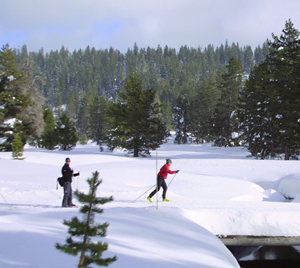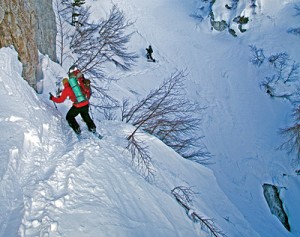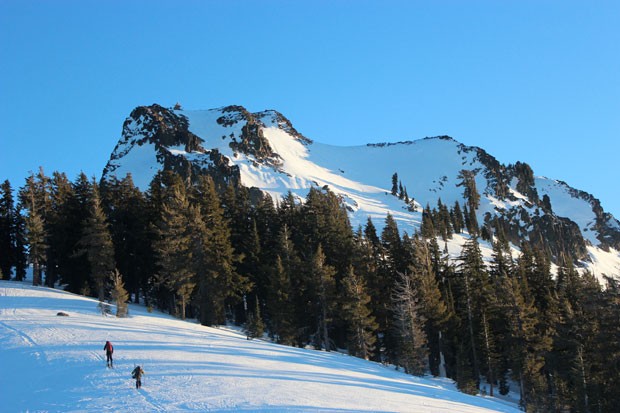- Tahoe’s Nevada Beach Tops the List of Hard-to-Book Campgrounds - 07/17/2024
- Cannabis Watershed Protection Program Cleans Up Illegal Grow Sites - 07/10/2024
- French Fire - 07/05/2024

Alpine Touring on Mount Humphries.
Photo: Mike Schwartz
What’s the deal with winter? If you are anything like me, winter is generally a bad time for fitness and outdoor sports. Oh sure, I try every year to resist the lure of massive holiday overeating, but inevitably I am ten pounds heavier and in lousy shape come spring. Then I spend spring and summer getting back into shape and the whole cycle starts again—fit and motivated in the summer, lazy, fat and uninspired in the winter. Gaining fitness in the summer; gaining weight in the winter. You get the picture.
Well, this year the cycle ends. The following snow primer is the result of an epiphany that can be summed up in three words: “TRAIN FOR SNOW.” In other words, I will not stumble into the winter outdoor sports season. This year I will start training weeks before the first snowflake hits the ground. This year I will set personal fitness goals and work hard to achieve them. Train for snow. Corny? Probably. But if you are anything like me, it sometimes helps to have a corny fitness mantra to help gain some much-needed momentum.
In this regard, we have asked a few experts in various snow sports to briefly describe what they love about their favorite winter activity. Maybe you are looking for your first winter sport to pursue as a fitness hobby. The following will serve as good introduction to a few popular snow sports. On the other hand, possibly you are a little tired of your old routine and would like to try something new. Well, clearly there are many options, from the mild to the wild. As a downhill skier you may want to switch to snowboarding, or maybe you are a cross-country skier wanting to up the adventure factor on tele-skis. Either way, getting out of a rut is crucial for all of us. The key is to make it fun and start getting ready NOW for this year’s snow season. Given the wide variety of snow sports (and the complicated gear that goes with each discipline) the following may clear up some confusion.
Finally, Olympic Skier and fitness instructor Eva Twardokens has some training advice. Contrary to popular opinion, occasional running and other cardio programs alone are NOT the best way to train for our most kick-butt snow season ever. Injury prevention should be the foundation for any snow fitness regimen, according to Eva. This makes sense, given that the first day back on the snow for most of us is a humbling barrage of spills, wipeouts, and near misses. Read Eva’s sidebar, and train for snow the right way. Because now is the time if you want to be snow fit come January. Train for snow—it’s not just an idea, it’s a victory chant. See you at the gym!
– Matt Niswonger
SNOWSHOEING
What’s the deal with snowshoeing?
Snowshoeing is truly a silent sport for those that enjoy trekking in a winter environment. It’s easy to learn; you can become an expert within a few steps. Snowshoes allow walking in comfort and stability over snow. Snowshoes are used for everything from taking a stroll about the meadow to climbing mountains, some folks actually run on the things. As a fitness activity, snowshoes offer a low-impact, safe form of exercise. For those that feel a little intimidated of slipping and gliding on skis, snowshoes are a great alternative.
Why do people love it?
Snowshoeing is straightforward, inspiring and great exercise. It’s just a matter of putting on another pair of shoes and off you go. Walking over snow gives one an aerobic workout while out enjoying nature with friends and family. Snowshoes are very maneuverable, so one can go places others cannot get to. They are simply the most hassle free way to enjoy an outdoor winter adventure.
Debbi Waldear is director of the Kirkwood Cross Country Ski and Snowshoe Center. She is an eight-time World Masters Ski Champion.
Cross-country skiing at Bear Valley.
Photos: Jared Brick.
CROSS COUNTRY SKIING
What’s the deal with cross-country skiing?
Cross-country skiing is a multi-faceted winter sport that is enjoyed by young and old alike. It can be done out the back door in any snowy landscape, or enjoyed at a facility that offers professionally groomed, mapped and signed trails. Unlike other snow sports, half of the participants are women. The rhythm and flow generated by the striding motion is almost dance-like and is very easy to learn. Like bicycling, there is a lot of glide on the flats, some effort required to go up, and often thrilling descents. Gear that is suitable for the various styles such as striding, ski skating, or backcountry touring can be rented or purchased. Instruction is recommended and prior experience with other balance-oriented activities (surfing, rollerblading, ice skating, etc.) can be very beneficial.
Why do people love it?
It’s been said (at least by me) that cross-country skiing is about the most fun you can have with your clothes on. Many enjoy the fact that it’s highly social. The quiet magic of skiing through an aspen forest, hidden meadow or scenic ridge-top is unparalleled. Modern gear has enhanced control and enjoyment. Simply adjust your pace to choose your desired level of exertion. It may be one of the best exercises out there, but it does not have to be a lot of work.
Paul Petersen is the owner of Bear Valley Cross Country on Ebbetts Pass and the author of The Essential Cross Country Skier, an excellent primer on the sport.
DOWNHILL SKIING
What’s the deal with skiing?
Most people think of “skiing” as a recreational downhill sport in which one visits a ski resort, purchases a lift ticket, and rides on a chair lift. Upon reaching the summit, the skier disembarks from the ski lift and travels downhill, propelled by gravity. Practiced by millions every winter, skiing actually requires quite a bit of skill. One should not attempt skiing unless trained at a ski school and proficient at turning and stopping safely. If you haven’t learned to turn, you will gain excessive speed, only to run into stationary objects such as trees. Modern downhill skis rely on a fixed-heel binding and sharp steel edges for control.
Why do people love it?
Staying in control is the key to having a good time on skis. As one gains skill and confidence, control can be maintained at high speeds and through varying terrain like moguls and trees. In time, skiing will begin to feel like flying. For many it is absolutely the most thrilling way imaginable to stay fit during the cold winter months. The feeling of cold mountain air blowing on your face as you hurl past beautiful pine trees, snow, and other skiers is an adrenaline rush that leaves many hopelessly addicted to the wonderful sport of downhill (also known as alpine) skiing.
Lorre Johnson has 46 years of skiing experience and has been a ski instructor for 22 years. Lorre currently works in the Guest Relations and Marketing Department at Sierra Summit Mountain Resort.
ALPINE TOURING
What’s the deal with Alpine Touring?
Alpine Touring, commonly shortened to “AT” and known in Europe as randonnee, refers to touring the winter alpine environment by your own power. AT gear is specifically designed to make hiking and skinning (using traction strips attached to the bottom of your skis, allowing uphill progress) possible on regular downhill skis. AT bindings allow your downhill skis to have a touring mode in which the heel releases to enable efficient ascent of snow-covered slopes.
In general, AT boots and bindings are much lighter and more comfortable than regular downhill gear. AT boots and bindings will help you fly up the hill and walk rocky ridges with confidence. Unless you huck cliffs or ski moguls, you should be very satisfied with AT performance while downhill skiing at a chair-lift resort.
Why do people love it?
Backcountry skiing is all about sniffing out the best snow conditions and terrain. Why fight for a tiny patch of fresh snow at the ski resort when endless backcountry powder waits? The beauty of Alpine Touring is that downhill skiers don’t have to learn a whole new sport to start exploring the backcountry. Like cycling, you can work as easy or hard as you want. Sliding your skis on snow is usually the fastest method of climbing and descending your favorite mountain summit.
To get in the AT game you’ll need some fairly soft and lightweight skis, preferably with a waist width of 85-95mm. Popular AT specific skis are made by Karhu, Black Diamond, K2, and G3. Keep in mind that converting your favorite downhill skis to Alpine Touring skis won’t work if your regular skis have integrated bindings. Don’t forget skins, adjustable poles, and avalanche rescue gear. Backcountry travel requires awareness, safety training, and experience.
Mike Schwartz is the owner of The Back Country with locations in Truckee and Tahoe City. Go to www.thebackcountry.net for a free Tahoe Backcountry Ski Guidebook.
TELEMARK SKIING
What is the deal with tele-skiing?
Telemark skiing is a graceful blend of nordic and alpine styles. It first appeared in a ski jumping contest in 1868 which Sondre Norheim won while using the telemark position to land. Sondre was from the Norwegian town of Telemark for which the new style was named. The telemark turn is easily recognized when a skier laterally separates their feet, one foot forward, one foot back, with the heel of the rear foot raised off the ski. Today telemark skiers use specialized nordic gear which in materials resembles alpine skiing equipment except the boots are more flexible and are only fastened to the skis at the toe.
Why do people love it?
A proficient telemark skier is smooth, graceful and strong. Good style requires almost constant motion and balance. A blend of power and grace translates into an exciting performance for both the skier and observer. However, telemark skiing is not easily learned and sometimes counter-intuitive to the veteran alpine skier or snowboarder. Often a few lessons or studying books such as Paul Parker’s “Freeheel Skiing” or Paul Petersen’s “The Complete Cross Country Skier” can quickly get you pointed in the right direction.
Aaron Johnson has been a professional ski instructor for 17 years and is the owner of Mountain Adventure Seminars (MAS) which hosts the Bear Valley Telemark Festival (www.mtadventure.com). Aaron is also an owner of the BaseCamp Lodge in Bear Valley which offers the best “sleep & ski” packages in the Sierra Nevada (www.basecamplodge.com).

Train for this. Big powder day at Heavenly.
Photo: Heavenly/Corey Rich.
SNOWBOARDING
What’s the deal with snowboarding?
Snowboarding has a little bit of something for everyone. Whether you’re an adrenaline junky who likes ripping through the steeps, a “park rat” who lives for big air in the half pipe and big jibs in the terrain park, or a “soul surfer” who loves to cruise through the big powder, snowboarding’s got you covered. Snowboarding has its roots in surfing (you originally could only buy snowboards at surf shops) and the two sports share many of the same physical movements and culture. Snowboarding also takes a lot of its influence from skateboarding, where you’ll recognize a lot of the same tricks and a lot of the same lingo.
Why do people love it?
Floating over the snow is an incredible sensation, and as one gains skills, high speed carving and aerial tricks provide limitless thrills and challenges. Also, boarding has become a unique cultural identity. Because it’s still relatively new, but also because it’s so pervasive, nobody can claim that they own snowboarding. That makes it a very welcoming environment and community.
Russ Pecoraro is Heavenly Mountain Resort’s Director of Communications. For more information on Heavenly, please visit www.skiheavenly.com.
SPLITBOARDING
What is a splitboard?
A splitboard is a hybrid snowboard that can split in half to become two skis. Designed for earning your turns in the backcountry, this schizophrenic chariot allows you to ascend harnessing the utility of skis and descend milking the bliss of snowboarding.
In ski mode, the bindings attach only at the toe allowing your heel to pivot like a telemark ski. Using traditional climbing skins the skis have tenacious uphill grip. At the top of the peak, the skins and bindings are removed and the skis get reassembled into a snowboard. Re-position the bindings to your snowboarding stance and the splitboard is ready to ride away.
Why do people love splitboarding?
Avid backcountry snowboarders embrace splitboarding, as the efficiency of skiing uphill has significant advantages over snowshoes in certain snow conditions and terrain. When a backcountry snowboarder slips their boots out of snowshoes and onto some split skis they instantly notice the increased floatation, the smooth glide of a free-heel stride, and the glory of a lighter backpack. When you’re chasing fresh tracks, moving lighter and faster is a huge benefit. Splitboards are ideal when the backcountry adventure demands traversing of rolling terrain, slugging through deep snow, or hauling a big pack. Fast laps on a short slope may require frequent transitioning, but with practice assembly of the splitboard in either orientation is quite easy. For backcountry snowboarders looking forward to ripping up remote peaks or touring to distant valleys, the splitboard may be the ultimate tool.
Seth Lightcap is a fiendish explorer whose addiction to adventure rarely lets him stand still. Splitboarding is the ultimate expression of his passion as it focuses the balance of skate/snowboarding, mountaineering and XC skiing in a single pursuit.














